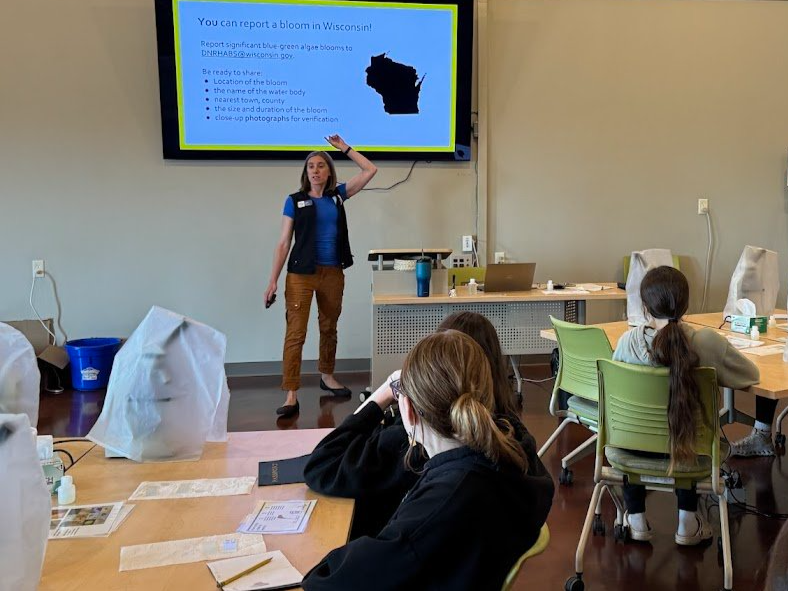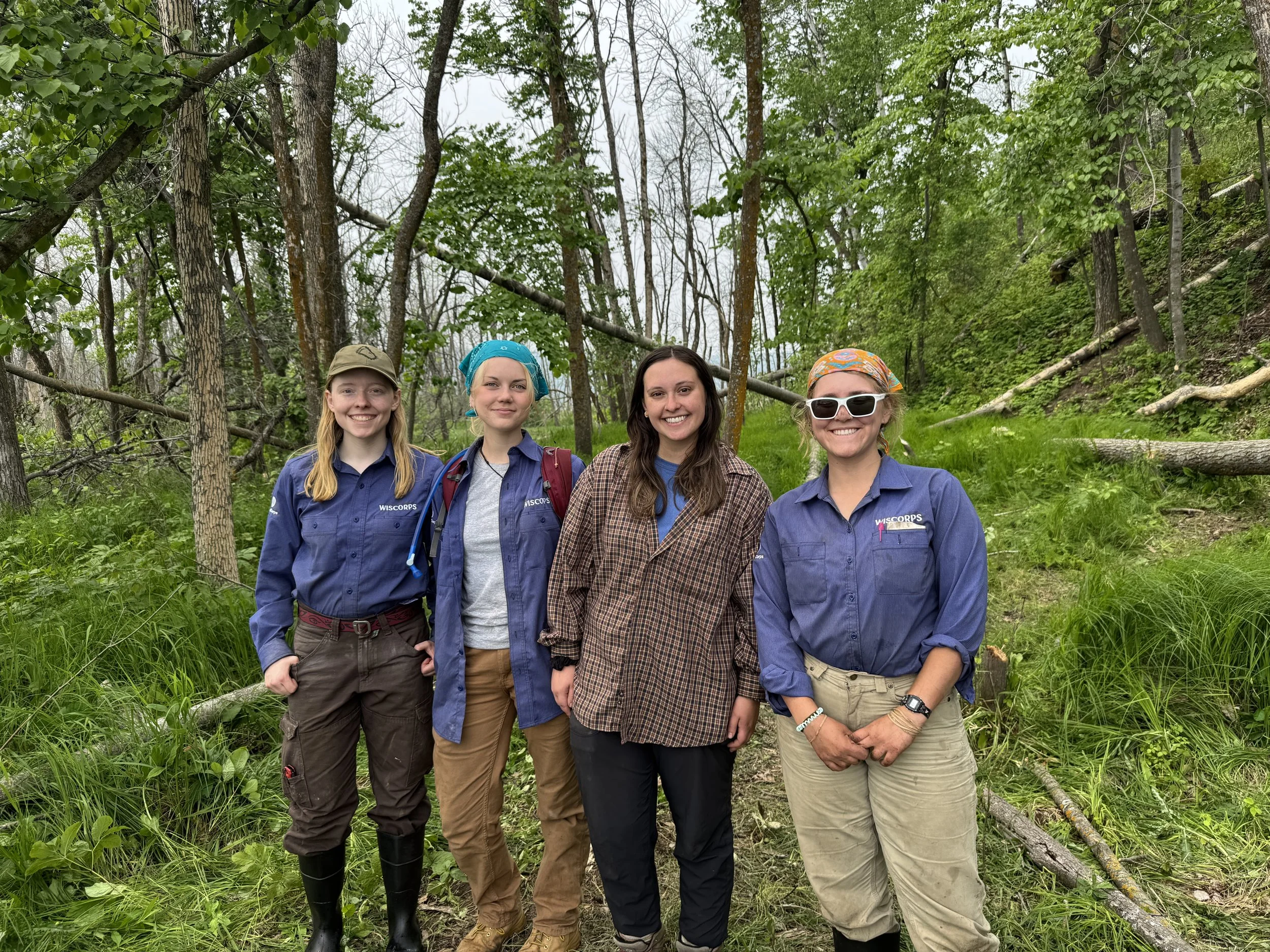What’s New at the Reserve? Summer 2025
This edition of "What's New at the Reserve?" includes updates on summer projects, events, and a new habitat map! With the start of a summer field season, the number of staff at the Lake Superior Reserve nearly doubled, including NOAA Holling Scholars, researchers, and educators, many of whom are students.
You'll find many of the staff all over the estuary, from the upper estuary islands, to Wisconsin Point, and Pokegama Bay. Summertime is science time!
Lake Superior Learning Days
Lake Superior Reserve’s Karina Heim teaches a station about harmful algal blooms and cyanobacteria. (credit: Luciana Ranelli)
The Lake Superior National Estuarine Research Reserve has collected data on the St. Louis River estuary since 2012, and that data is beneficial to every community member that lives along its shores. One of the most rewarding parts of the Lake Superior Reserve is putting the collected data into action for the community.
Much of the research, outreach, and education work of the Reserve came together in a three-day event called Lake Superior Learning Days, coordinated by the Reserve’s education team (Luciana Ranelli, Ryan Feldbrugge, and Lauryn Cartee) and Superior Middle School teachers. Every single eighth grader from the Superior Public School District made their way to the Lake Superior Estuarium on Barker's Island between June 2, 3, or 4 to learn about water science, local ecology, and the people living in this important place.
Reserve staff were joined by teachers from Superior Middle School, the Lake Superior Research Institute (part of the University of Wisconsin-Superior), and Mark and Mary McConnell (elder and member of the Fond du Lac Band of Lake Superior Ojibwe). Eighth grade students explored outdoors at the headwaters of Lake Superior, rotating through five stations: finding balance by making driftwood mobiles, testing the waters of the estuary using water chemistry kits, learning about Ojibwe culture and history from Mark and Mary McConnell, identifying types of toxic cyanobacteria that can cause harmful algal blooms using microscopes, and participating in a lesson about invasive species of the area.
Fox 21 Local News featured a story about Lake Superior Learning Days, which you can learn about by clicking here: Superior Middle Schoolers Test Science Class Knowledge Outdoors
Tree Planting on Clough Island
Wisconsin Conservation Corps (WisCorps) crew gathers for a photo on Clough Island (credit: Kirsten Rhude)
Stewardship encompasses the work of the Lake Superior Reserve to restore and maintain our estuarine habitats. Kirsten Rhude, the Lake Superior Reserve Stewardship Coordinator, is in charge of planning and executing this important work of the Reserve. Among the many projects happening at the reserve is “Restoring Lake Superior’s Wetland Forests”.
A Great Lakes Restoration Initiative project spanning the upper and lower estuary, restoring Lake Superior’s Wetland Forests has taken multiple years and several agencies to accomplish. Every summer for the past three years, the Lake Superior Reserve has enlisted the help of the Wisconsin Conservation Corps (a state and national AmeriCorps program) and the Wisconsin Department of Natural Resources (DNR).
The 2025 portion of this project was focused on the low-lying peninsula of Clough Island, the largest island in the St. Louis River estuary. This habitat was affected by two critical invasive species: Emerald Ash Borer (EAB) and common buckthorn. EAB is a small emerald-green bug that burrows into ash trees. This causes the trees to die from disruption to their water and nutrient intake with a 99% mortality rate. With the ash forests nearly gone, common buckthorn made its way into the open understory. Another WisCorps crew pulled treated buckthorn from the peninsula last fall, leaving the understory ready for tree saplings this summer.
Together with WisCorps, Wisconsin DNR, and the Lake Superior Reserve, the first two weeks of June were spent planting trees on Clough Island. Several species were planted, including but not limited to Swamp White Oak, River Birch, Black Spruce, White Pine, Yellow Birch, and Sugar Maple. 9,000 tree saplings were planted on Clough Island by the Lake Superior Reserve and WisCorps, with a grand total of 32,000 trees planted as part of the three year project.
New Habitat Map
The Lake Superior Reserve, along with partners, developed a new St. Louis River estuary habitat map. This project helps address needs of the the St. Louis River Habitat Workgroup and the delisting of the St. Louis River as a U.S. Environmental Protection Agency (EPA) Great Lakes Area of Concern. You can read more about Areas of Concern from the U.S. EPA by vising their website here: Great Lakes Areas of Concern
This habitat map, which encompasses 21 miles of the St. Louis River habitat below the Fond du Lac dam, provides an analysis of the various types of habitat present. It will inform the Lake Superior Reserve and its many partners on ways to protect and steward the habitats, create new plans of restoration, and act as a resource for different agencies working together on the St. Louis River estuary.
Photo of the 2024 St. Louis River Estuary Habitat Map (credit: Kirsten Rhude)
Ishkode on Wisconsin Point
A fire scar on a red pine tree on Wisconsin Point, revealing the history of fire from years past (credit: Callie Grones)
Ishkode (Ojibwe for “fire”) has been used as a tool for land management and reciprocity by Ojibwe people residing on Wisconsin Point. When the territory was ceded and the U.S. government forcibly removed residents from the point, good fires ceased. Today, a century of no fire caused an unhealthy red pine forest and lack of plant diversity. As a fire dependent species, red pine cannot regenerate without the use of fire, and other pyrogenic plants (plants that respond well to fire) cannot thrive. Additionally, good fire helps with blueberry production and biodiversity in plants of the understory (plant life that grows on the ground under the tree canopy).
A collaborative team from the Lake Superior Reserve, City of Superior, Superior Fire Department, Fond du Lac Band of Lake Superior Ojibwe, and The Nature Conservancy are developing a plan to reintroduce fire to Wisconsin Point. This is ecologically beneficial to Wisconsin Point in the long term, as well as provides an opportunity for collaboration in a space where Ojibwe people have been using fire historically for centuries. Two spaces on Wisconsin Point were identified as places where fire will be reintroduced over the coming seasons.
The first burn on Wisconsin Point is set to take place in Fall 2025 for approximately 5 acres of Wisconsin Point alongside Wisconsin Point Road. This burn will assist with clearing out the understory, making way for blueberry production and red pine regeneration. A second burn is planned for Spring 2026 in the red pine plantation at the end of Wisconsin Point near Lot #5. There, the red pines are incredibly dense, preventing growth of nearly any plants in the understory, the current red pines, or red pine saplings. Thinning of the Lot #5 plantation of red pines is planned to take place in Winter 2026 so that a prescribed fire can be lit safely. The thinning will also assist in establishing a healthier red pine plantation and a biodiverse understory. The pine plantation is planned to burn in Spring 2026.
Community members who want to know more about this project are encouraged to visit the City of Superior’s website at the link here: Superiorwi.gov/ishkode
Article by Callie Grones
Cover photo: Reserve staff celebrate another successful Lake Superior Day. (credit: Luciana Ranelli)




